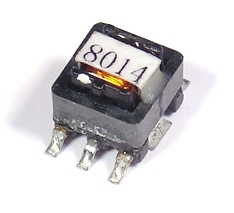Table of Contents
Current sensor
| Stan Zurek, Current sensor, Encyclopedia Magnetica, https://e-magnetica.pl/doku.php/current_sensor |
| reviewed by Jeanete Leicht, 2013-04-04 |
Current sensor1), current transducer2) or current probe3) - any type of sensor or transducer used for measurement or detection of electrical current.
A current sensor provides means of converting the input signal to a different level or different physical quantity. There are a number of physical phenomena which can be employed for current sensing. Many of them involve various means of magnetic coupling, but there are several in which magnetism does not play significant role.
The output signal of a current sensor is typically voltage (as in a shunt resistor) or current (as in a current transformer).
| → → → Helpful page? Support us! → → → | PayPal | ← ← ← Help us with just $0.10 per month? Come on…  ← ← ← |
Examples of current sensors
An example of the simplest current sensor is a non-inductive resistor which is inserted directly into the path of the current to be detected. The voltage drop across such resistor is directly proportional to the current flowing through it, so there is a conversion from current to voltage (which is generally easier to measure. The major disadvantage is lack of galvanic separation4), but also heat dissipation.5)
Many current sensors are based on magnetic coupling, in which a significant place is held by current transformers, which electromagnetically transform the amplitude of the primary current into secondary current of usually different amplitude. They can offer full galvanic separation, but without special circuits they are unable to detect the DC component of the current. This is an inherent problem of all current probes based only on the effect of magnetic induction.
There is another class of sensors detecting magnetic field generated the current, and hence the value of the current. The magnetic field is guided by a magnetic core, but the actual detection is achieved not by induction coil, but by a Hall-effect, fluxgate, magnetoresistive, and so on.6) The construction of such sensors is more complex, but they are capable of detecting AC as well as DC components. They are sometimes referred to as DC current transformers.7)
Faraday effect is also used in some modern applications. They can offer a high degree of galvanic isolation required for instance in high-voltage applications.8)9)
There numerous other effects and phenomena which can be used for current sensing, without and with electrical isolation. Some of these are more popular than others and the exact implementation depends very strongly on the level of current to be measured, frequency of operation, required accuracy, etc. Most of these are at various degrees of research or development and might not be always available commercially.
Vast majority of presently available industrial sensors are still based on magnetic effects. 10) And even shunt resistors are best to be non-inductive, as parasitic inductance causes additional voltage drop (hence errors) at elevated frequencies.11)
Photos and images

S. Zurek, E-Magnetica.pl, CC-BY-4.0
S. Zurek, E-Magnetica.pl, CC-BY-4.0
Examples of current sensors and transducers
- Hall-effect current sensor (open loop and closed loop)



